Growing cilantro from seeds on a windowsill at home
Cilantro on the windowsill is still a rare guest; meanwhile, growing this greenery is no more difficult than parsley or dill. The spicy plant has a specific aroma that is not pleasant to everyone, but the herb has its own devoted fans. Cilantro seeds are known by another name - coriander. They are used as a spice. Success in growing spices largely depends on the choice of quality seeds and a suitable place in the apartment, preparatory measures and further plant care.
Choosing the right place
In the garden, cilantro grows best in sunny areas. The light needs of the plant must also be taken into account when growing indoors. If possible, it is better to choose the most illuminated window sill from the south or east side. If you have only a west or north window at your disposal, you cannot do without the use of backlighting.
With sufficient light, cilantro will grow well, and its leaves will acquire a rich, bright color. Lack of light deprives the plant of strength, it grows poorly, differs in elongated stems and rare leaves.
For illumination, you can use fluorescent lamps and fluorescent lamps: they are economical, do not emit excessive heat and provide uniform illumination. The best option is to use phytolamps specially designed to illuminate indoor plants. However, purchasing such equipment will be quite costly.
Don't worry if it's cool on the windowsill. Despite the fact that cilantro is native to warm countries, the plant is not too sensitive to low temperatures.
Planting capacity
To plant cilantro at home, you do not need any special container. A used flower pot or plastic container 25–30 cm high is fine.
Part of the volume will be occupied by the drainage layer. As drainage, you can use:
- expanded clay;
- foam crumbs;
- broken brick;
- clay shards.
Before use, the pot must be thoroughly rinsed and rinsed with boiling water for disinfection purposes. The bottom of the container must contain several drainage holes for excess liquid to drain out after watering. When using ceramics, it is better to refuse products covered with glaze. Preference should be given to ordinary clay pots with porous walls that allow air to pass through.
Elongated plastic containers are well suited for growing greenery, where several bushes of the same or different types can grow at once. Rectangular containers should also be used if long fluorescent lamps are selected for illumination. Under such conditions, the lighting will be organized optimally.
Ground requirements
Growing cilantro from seeds will not give a good result when sown in poor soil. For planting, you can take different soil, the main thing is that it is loose and fertile. This could be:
- nutritious garden soil;
- purchased universal soil;
- a mixture of equal parts of turf and humus with the addition of 0.5 part of sand.
The soil must be disinfected by steaming in the oven for 20-30 minutes. This procedure can be replaced with a hot solution of potassium permanganate. Purchased soil does not need to be processed, it goes through all the necessary procedures in production.
Land preparation should be done 5-7 days before the expected sowing date.By the time of planting, excess moisture should evaporate from the soil, and it will take time to restore the soil microflora.
Sowing terms and features
For growing at home, it is better to choose varieties that give compact bushes, for example "Prelest", "Ray", "Shiko". Adult specimens of these varieties reach a height of 50–55 cm. The varieties also differ in terms of ripening. The growing season for cilantro lasts an average of 35–45 days. If the goal is to grow greens on the windowsill all winter, sowing should be done at intervals of 30 days.
When buying seeds, pay attention to the expiration date. After 2 years from the moment of collection, the germination rate of the seed is significantly reduced.
You cannot buy coriander sold in grocery stores for planting, since these seeds have been heat treated and will not sprout anymore.
Before planting, it is advisable to soak the seeds in warm water for 2-3 hours. Moisture will soften the shell, allowing the seeds to hatch faster. The germination percentage in this case will also be higher.
Sowing can be done at any time of the year. Of course, in the fall and winter, the plants will need more care, in particular, the organization of the daily lighting.
In practice, the seeding procedure is as follows:
- Drainage is laid on one prepared container.
- The container is then filled with slightly damp soil.
- The soil should be homogeneous in structure - large clods are crushed.
- Use any suitable object to make holes 2 cm deep at a distance of 5–6 cm from each other and place seeds in them.
- Top seeds are lightly sprinkled with dry earth.
After sowing, lightly spray the surface of the soil from a spray bottle and cover with a film to create greenhouse conditions. Now the container with crops must be placed in the warmest place of the apartment. After the sprouts hatch, the shelter is removed and the container is rearranged to the most illuminated place.
Caring for cilantro while growing
For the full development of greenery, you need to create the most comfortable conditions. The backlight is switched on daily for 5-9 hours, depending on the length of daylight hours. The culture calmly tolerates temperatures of 7-10 ° C, but still it should not be overused by arranging long-term ventilation, as in this case the growth of cilantro will slow down. The plant will develop best at a temperature of 20-25 ° C. Drafts when growing greenery on the window are unacceptable.
To keep the bush even and fluffy, the container is turned from time to time with the other side facing the light. In this case, the cilantro will develop evenly.
If the crops turned out to be thickened, as the seedlings grow, they are thinned out.
Plants should not be allowed to bloom. Peduncles are removed as soon as they appear. The overgrown leaves are cut off with scissors or gently pinched off by hand.
Watering, feeding
Watering should be regular but moderate. Kinza needs moisture, but she cannot stand waterlogging. The remaining water after irrigation must be drained from the pan. The water is preliminarily defended during the day, its temperature should be at least room temperature. You can increase the humidity in the room by spraying the air near the plants or by installing a household humidifier on the windowsill.
For the entire growth period, cilantro is fed 2 to 4 times, assessing the condition of the bushes. For feeding, use a mineral complex fertilizer, for example, "Ideal" or "Rainbow" in liquid form. To prepare the nutrient solution, dilute 10 ml (2 tsp) of fertilizer in 1 liter of water. It is necessary to water the greens with mineral dressing at the root a few hours after the usual watering.
Possible diseases
Due to non-compliance with the conditions of keeping, cilantro can be affected by fungal diseases.
- Ramulariasis occurs in conditions of high air humidity, manifesting itself as the appearance of rusty-brown spots.
- If the air, on the other hand, is too dry and warm, the plant can get sick with powdery mildew, a characteristic feature of which is a white fluffy coating that affects the leaves.
At the first signs of both diseases, the affected branches should be cut off on the bushes and the conditions should be adjusted. At high air humidity, spraying is excluded, watering is somewhat reduced. If the room, on the contrary, is dry and hot, more often arrange ventilation, turn on a humidifier. To protect against fungus, you can spray the leaves with a solution of milk whey diluted in half with water.
Pests at home do not infect the culture if the soil has been disinfected.
Growing cilantro on a windowsill will allow you to have fresh greens throughout the year absolutely free. For sowing, high-quality seeds, suitable containers and soil are selected. Further care of the seedlings is not particularly difficult. You should organize the backlight, regularly water the grass, apply liquid fertilizer. After 3-4 weeks the first young leaves can be cut off.
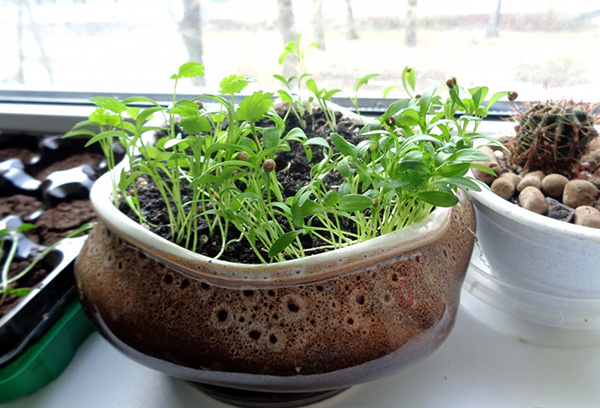
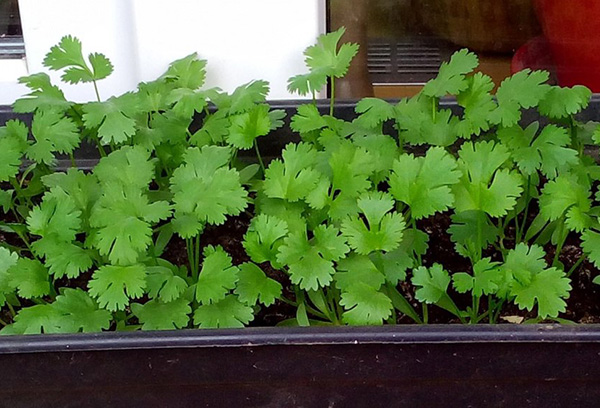
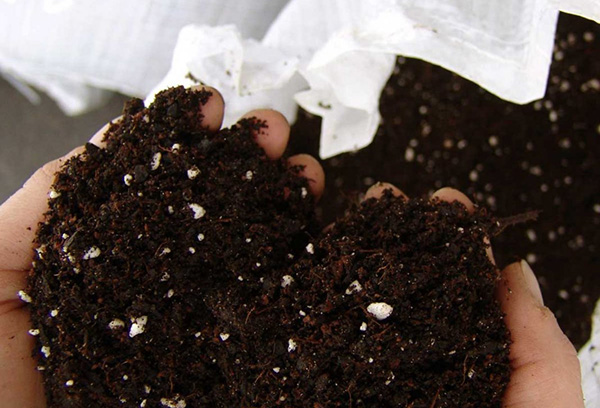
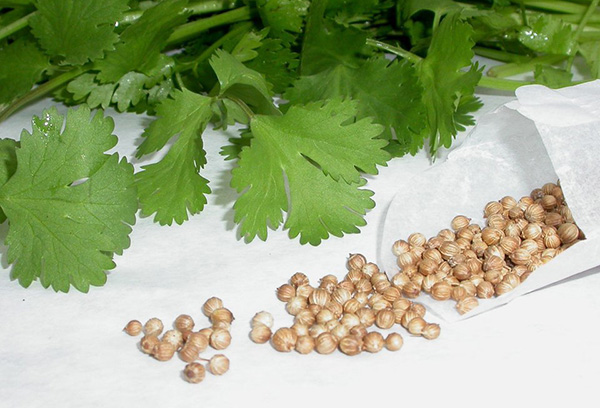
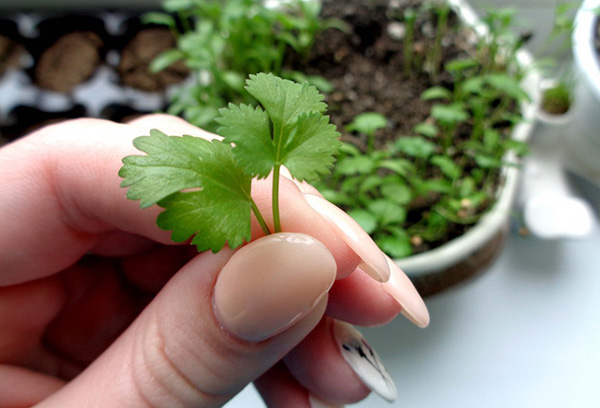
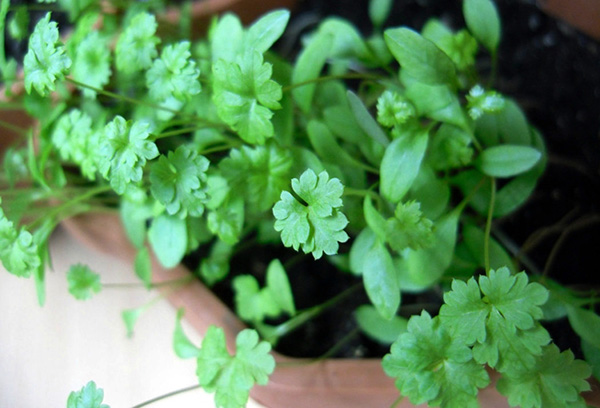


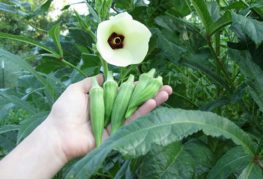
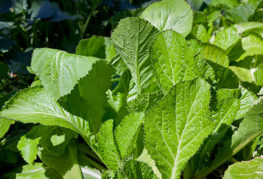
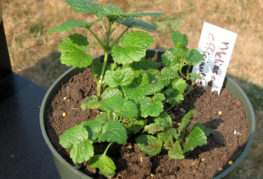

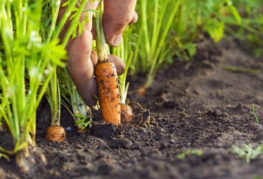
and will be published shortly.